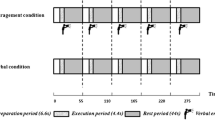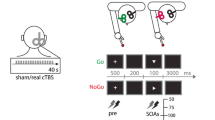Abstract
In this study, we used fMRI to identify brain regions associated with concentration (sustained attention) during a motor preparation task. In comparison with a non-concentration task, increased activities were observed (P < 0.05, FWE-corrected P values) in cerebellar lobules VI and VII, motor cortex, pre-supplementary motor area (pre-SMA), thalamus, red nucleus (RN), and caudate nucleus (CN). Moreover, analysis of effective connectivity inter-areal (psychophysiological interactions) showed that during preparation, concentration-related brain activity increase was dependent on Cerebello-thalamo-pre-SMA-RN and Pre-SMA-CN-thalamo-M1 loops. We postulate that, while pre-SMA common to both loops is specifically involved in the movement preparation and readiness for voluntary movement through the striatum, the cerebellar lobule VI in conjunction with RN, likely through a cerebellar-rubro-olivary-cerebellar loop, might be implicated in concentration-related optimization of upcoming motor performances.




Similar content being viewed by others
References
Cunnington R, Windischberger C, Deecke L, Moser E. The preparation and readiness for voluntary movement: a high-field event-related fMRI study of the Bereitschafts-BOLD response. NeuroImage. 2003;20(1):404–12.
Nguyen VT, Breakspear M, Cunnington R. Reciprocal interactions of the SMA and cingulate cortex sustain premovement activity for voluntary actions. J Neurosci. 2014;34(49):16397–407.
Thickbroom G, Byrnes M, Sacco P, Ghosh S, Morris I, Mastaglia F. The role of the supplementary motor area in externally timed movement: the influence of predictability of movement timing. Brain Res. 2000;874(2):233–41.
Rizzolatti G, Fadiga L, Gallese V, Fogassi L. Premotor cortex and the recognition of motor actions. Brain Res Cogn Brain Res. 1996;3(2):131–41.
Yazawa S, Ikeda A, Kunieda T, Ohara S, Mima T, Nagamine T, et al. Human presupplementary motor area is active before voluntary movement: subdural recording of Bereitschaftspotential from medial frontal cortex. Exp Brain Res. 2000;131(2):165–77.
Purzner J, Paradiso GO, Cunic D, Saint-Cyr JA, Hoque T, Lozano AM, et al. Involvement of the basal ganglia and cerebellar motor pathways in the preparation of self-initiated and externally triggered movements in humans. J Neurosci. 2007;27(22):6029–36.
Weilke F, Spiegel S, Boecker H, von Einsiedel HG, Conrad B, Schwaiger M, et al. Time-resolved fMRI of activation patterns in M1 and SMA during complex voluntary movement. J Neurophysiol. 2001;85(5):1858–63.
Lee K-M, Chang K-H, Roh J-K. Subregions within the supplementary motor area activated at different stages of movement preparation and execution. NeuroImage. 1999;9(1):117–23.
MacKinnon C, Bissig D, Chiusano J. Preparation of anticipatory postural adjustments prior to stepping. J Neurophysiol. 2007;97(6):4368–79.
Akkal D, Dum RP, Strick PL. Supplementary motor area and presupplementary motor area: targets of basal ganglia and cerebellar output. J Neurosci. 2007;27(40):10659–73.
Sussman D, Leung R, Chakravarty M. The developing human brain: age-related changes in cortical, subcortical, and cerebellar anatomy. Brain Behav. 2016;6(4):e00457.
Rondi-Reig L, Paradis A-L, Lefort JM, Babayan BM, Tobin C. How the cerebellum may monitor sensory information for spatial representation. Front Syst Neurosci. 2014;8:205.
Richard A, Van Hamme A, Drevelle X, Golmard J-L, Meunier S, Welter M-L. Contribution of the supplementary motor area and the cerebellum to the anticipatory postural adjustments and execution phases of human gait initiation. Neuroscience. 2017;358:181–9.
D’Angelo E, Mazzarello P, Prestori F, Mapelli J, Solinas S, Lombardo P, et al. The cerebellar network: from structure to function and dynamics. Brain Res Rev. 2011;66(1–2):5–15.
Shadmehr R, Krakauer JW. A computational neuroanatomy for motor control. Exp Brain Res. 2008;185(3):359–81.
Proudfoot M, Rohenkohl G, Quinn A, Colclough GL, Wuu J, Talbot K, et al. Altered cortical beta-band oscillations reflect motor system degeneration in amyotrophic lateral sclerosis. Hum Brain Mapp. 2017;38(1):237–54.
Fekete T, Zach N, Mujica-Parodi L, Turner M. Multiple kernel learning captures a systems-level functional connectivity biomarker signature in amyotrophic lateral sclerosis. PLoS One. 2013;8(12):e85190.
Habas C, Kamdar N, Nguyen D, Prater K. Distinct cerebellar contributions to intrinsic connectivity networks. J Neurosci. 2009;29(26):8586–94.
Manto M, Jissendi P. Cerebellum: links between development, developmental disorders and motor learning. Front Neuroanat. 2012;6:1.
Nioche C, Cabanis E. Functional connectivity of the human red nucleus in the brain resting state at 3T. AJNR Am J Neuroradiol. 2009;30(2):396–403.
Liu Y, Pu Y, Gao J, Parsons L, Xiong J. The human red nucleus and lateral cerebellum in supporting roles for sensory information processing. Hum Brain Mapp. 2000;10(4):147–59.
Penhune V, Steele C. Parallel contributions of cerebellar, striatal and M1 mechanisms to motor sequence learning. Behav Brain Res. 2012;226(2):579–91.
Albouy G, King B, Maquet P, Doyon J. Hippocampus and striatum: dynamics and interaction during acquisition and sleep-related motor sequence memory consolidation. Hippocampus. 2013;23(11):985–1004.
Grahn J, Parkinson J, Owen A. The cognitive functions of the caudate nucleus. Prog Neurobiol. 2008;86(3):141–55.
Belkhiria C, Driss T, Habas C, Jaafar H, Guillevin R, de Marco G. Exploration and identification of cortico-cerebellar-brainstem closed loop during a motivational-motor task: an fMRI study. Cerebellum. 2017;16(2):326–39.
Tzourio-Mazoyer N, Landeau B, Papathanassiou D, Crivello F, Etard O, Delcroix N, et al. Automated anatomical labeling of activations in SPM using a macroscopic anatomical parcellation of the MNI MRI single-subject brain. NeuroImage. 2002;15(1):273–89.
Satoshi H, Koji J, Akira K, Osamu A, Kuni O, Yasushi M, et al. Changes in cerebro-cerebellar interaction during response inhibition after performance improvement. NeuroImage. 2014;99:142–8.
Stephan K, Marshall J, Friston K, Rowe J. Lateralized cognitive processes and lateralized task control in the human brain. Science. 2003;301(5631):384–6.
Padoa-Schioppa C, Li CSR, Bizzi E. Neuronal correlates of kinematics-to-dynamics transformation in the supplementary motor area. Neuron. 2002;36(4):751–65.
Smith AM, Bourbonnais D, Blanchette G. Interaction between forced grasping and a learned precision grip after ablation of the supplementary motor area. Brain Res. 1981;222(2):395–400.
Cramer SC, Weisskoff RM, Schaechter JD, Nelles G, Foley M, Finklestein SP, et al. Motor cortex activation is related to force of squeezing. Hum Brain Mapp. 2002;16(4):197–205.
Luppino G, Rizzolatti G. The organization of the frontal motor cortex. News Physiol Sci. 2000;15:219–24.
Kendall FP, Kendall FP. Muscles: testing and function with posture and pain: Lippincott Williams & Wilkins; 2005.
Visser JE, Bloem BR. Role of the basal ganglia in balance control. Neural Plast. 2005;12(2–3):161–74.
Habas C, Cabanis E. Cortical projections to the human red nucleus: a diffusion tensor tractography study with a 1.5-T MRI machine. Neuroradiology. 2006;48(10):755–62.
Ghez C, Vicario D. The control of rapid limb movement in the cat. II. Scaling of isometric force adjustments. Exp Brain Res. 1978;33(2):191–202.
Ishikawa T, Tomatsu S, Izawa J, Kakei S. The cerebro-cerebellum: could it be loci of forward models? Neurosci Res. 2016;104:72–9.
Cerasa A, Hagberg GE, Peppe A, Bianciardi M, Gioia MC, Costa A, et al. Functional changes in the activity of cerebellum and frontostriatal regions during externally and internally timed movement in Parkinson’s disease. Brain Res Bull. 2006;71(13):259–69.
Strick PL, Dum RP, Fiez JA. Cerebellum and nonmotor function. Annu Rev Neurosci. 2009;32(1):413–34.
Schmahmann JD. The role of the cerebellum in cognition and emotion: personal reflections since 1982 on the dysmetria of thought hypothesis, and its historical evolution from theory to therapy. Neuropsychol Rev. 2010;20(3):236–60.
Leiner HC. Solving the mystery of the human cerebellum. Neuropsychol Rev. 2010;20(3):229–35.
Boecker H, Jankowski J, Ditter P, Scheef L. A role of the basal ganglia and midbrain nuclei for initiation of motor sequences. NeuroImage. 2008;39(3):1356–69.
Stoodley CJ, Valera EM, Schmahmann JD. Functional topography of the cerebellum for motor and cognitive tasks: an fMRI study. NeuroImage. 2012;59(2):1560–70.
Ng THB, Sowman PF, Brock J, Johnson BW. Neuromagnetic brain activity associated with anticipatory postural adjustments for bimanual load lifting. NeuroImage. 2013;66:343–52.
Bradfield LA, Balleine BW. Thalamic control of dorsomedial striatum regulates internal state to guide goal-directed action selection. J Neurosci. 2017;37(13):3721–33.
Sang L, Qin W, Liu Y, Han W, Zhang Y, Jiang T, et al. Resting-state functional connectivity of the vermal and hemispheric subregions of the cerebellum with both the cerebral cortical networks and subcortical structures. NeuroImage. 2012;61(4):1213–25.
Sege CT, Bradley MM, Lang PJ. Startle modulation during emotional anticipation and perception. Psychophysiology. 2014;51(10):977–81.
Chudasama Y, Robbins TW. Functions of frontostriatal systems in cognition: comparative neuropsychopharmacological studies in rats, monkeys and humans. Biol Psychol. 2006;73(1):19–38.
Redgrave P, Gurney K. The short-latency dopamine signal: a role in discovering novel actions? Nat Rev Neurosci. 2006;7(12):967–75.
Bar-Gad I, Morris G, Bergman H. Information processing, dimensionality reduction and reinforcement learning in the basal ganglia. Prog Neurobiol. 2003;71(6):439–73.
Frank MJ. Computational models of motivated action selection in corticostriatal circuits. Curr Opin Neurobiol. 2011;21(3):381–6.
Gurney KN, Humphries M, Wood R, Prescott TJ, Redgrave P. Testing computational hypotheses of brain systems function: a case study with the basal ganglia. Network. 2004;15(4):263–90.
Humphries MD, Stewart RD, Gurney KN. A physiologically plausible model of action selection and oscillatory activity in the basal ganglia. J Neurosci. 2006;26(50):12921–42.
Kawagoe R, Takikawa Y, Hikosaka O. Expectation of reward modulates cognitive signals in the basal ganglia. Nat Neurosci. 1998;1(5):411–6.
Kawaguchi Y, Wilson CJ, Emson PC. Projection subtypes of rat neostriatal matrix cells revealed by intracellular injection of biocytin. J Neurosci. 1990;10(10):3421–38.
Smith AD, Bolam JP. The neural network of the basal ganglia as revealed by the study of synaptic connections of identified neurones. Trends Neurosci. 1990;13(7):259–65.
Schultz W, Apicella P, Ljungberg T, Romo R, Scarnati E. Reward-related activity in the monkey striatum and substantia nigra. Prog Brain Res. 1993;99:227–35.
Ness V, Beste C. The role of the striatum in goal activation of cascaded actions. Neuropsychologia. 2013;51(13):2562–71.
Author information
Authors and Affiliations
Corresponding author
Ethics declarations
Conflict of Interest
The authors declare that they have no conflict of interest.
Rights and permissions
About this article
Cite this article
Belkhiria, C., Mssedi, E., Habas, C. et al. Collaboration of Cerebello-Rubral and Cerebello-Striatal Loops in a Motor Preparation Task. Cerebellum 18, 203–211 (2019). https://doi.org/10.1007/s12311-018-0980-z
Published:
Issue Date:
DOI: https://doi.org/10.1007/s12311-018-0980-z




